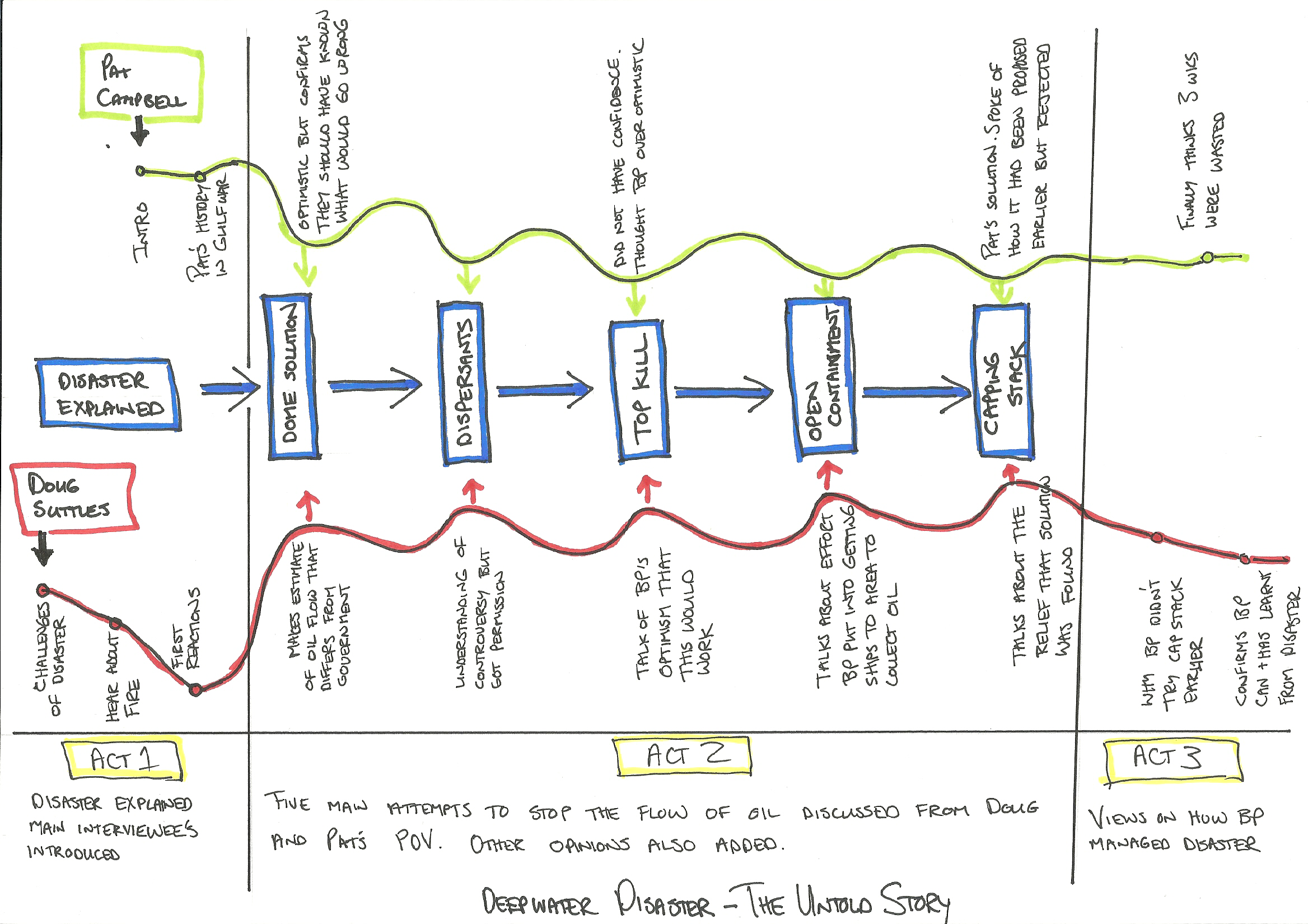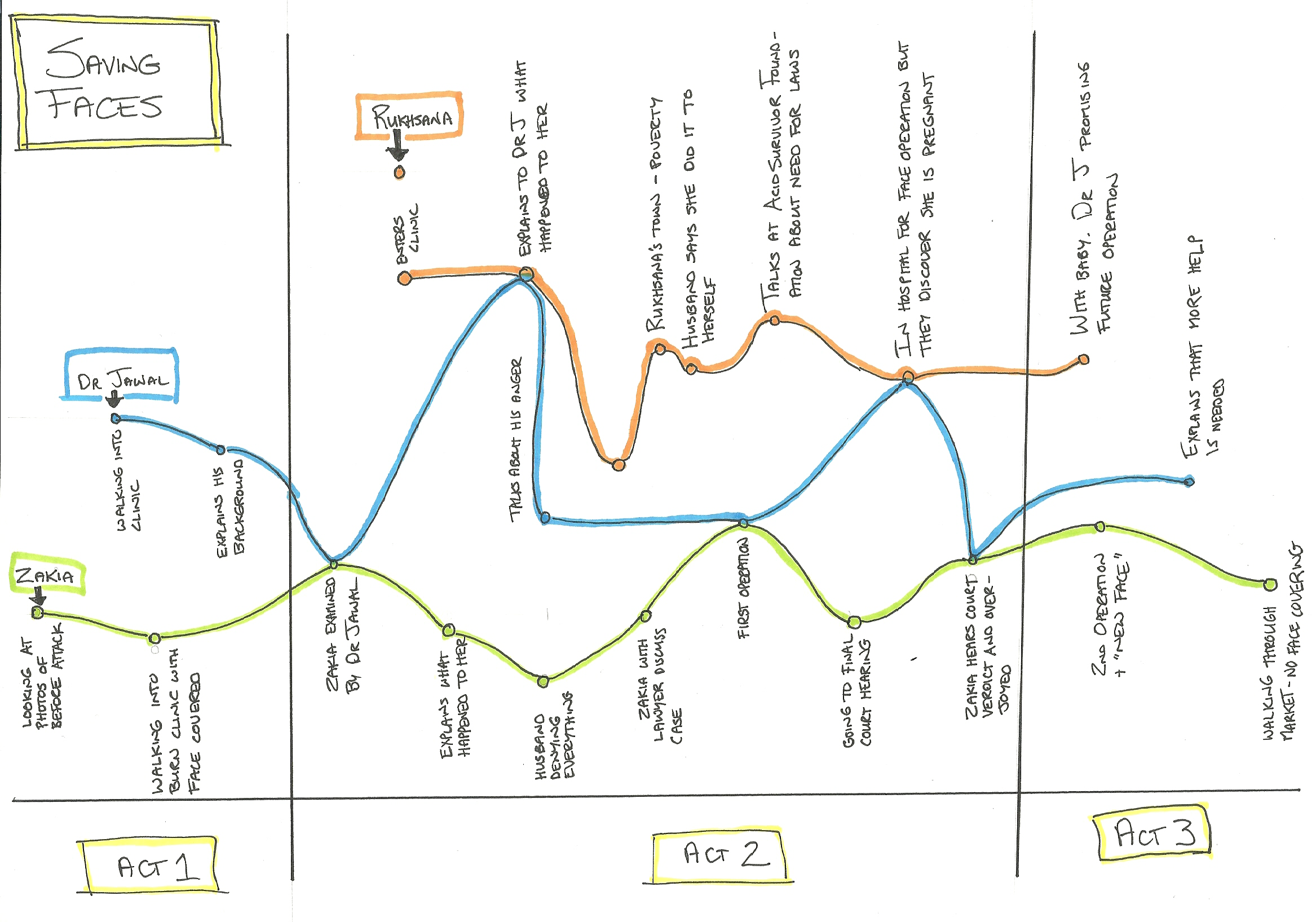For this exercise, two documentaries are chosen and then analyzed so that their narrative structure can be represented in a diagram. One of the documentaries needed to be of the ‘telling’ variety, whereas the second one needed to be an ‘asking’ type documentary.
The first documentary that I chose was the BBC Horizon Deepwater Disaster – The Untold Story. Due to the extremely contentious nature of the disaster, the huge cost to the ecosystem and the livelihood of those who fish in those waters and the politics of deep sea oil wells, I expected this documentary to be a ‘telling’ type and that there would be a strong point being made. As it turned out, this documentary was more about asking why it took 87 days to get the well under control.
There was some, but very little, focus on the devastation that was caused. The main focus was on documenting the various solutions that were tried, why they didn’t work and what eventually did work. The presentation appeared factual and attempted to be neutral although ultimately the message that does come through (by asking) is that BP did not believe it was possible for this disaster to happen and consequently were not prepared or equipped to managed when the well blew.

The documentary is told through the experiences of two main people; Doug Suttles, COO Exploration and Production BP and Pat Cambpell, CEO of Wild Wells Control and BPs contracted well control advisor. Other views where expressed by various engineers and scientist and a semi-prominent opinion of Admiral Thad Allen, US National Incident Commander at the time.
The narrative revolves around the five different attempts to get the well under control and Doug and Pat’s views of the challenges they faces with each of these attempts. Doug, as a representative of BP gives his version of events in as positive a way as he could, whereas Pat was more pessimistic in his views of some of the solutions and the timings for some of the choices that were made. Although their opinions differed, sometimes only slightly and at other times quite significantly, the narrator does not attempt to draw conclusions but lets the viewer decide for themselves. Neither does the documentary appear to attempt to shock the viewer with lots of emotionally charged images of dead or harmed animals, but rather chooses images of the underwater operations and people in the control room trying to find solutions.
____________________
I also viewed the documentary by Sharmeen Obaid-Chinoy called Saving Faces. This documentary, about the victims of acid attacks in Pakistan, won an Academy Award in 2012 for the Best Documentary (Short Subject). The documentary is very definitely one that has a point to make about the criminality of acid attacks and the way in which it ruins lives, and a call to action.
The documentary is told through the experiences of three characters; Dr Mohammad Jaweel, a Pakistan-born doctor living in London who goes back to Pakistan to do plastic surgery on woman who have been burnt by acid. The second is Zakia, a woman who was burnt by her husband because after many years of abuse she decided to ask for a divorce. Outside the courtroom her husband threw acid in her face. Zakia took her husband to court over the attack. The third is Rukhsana, a woman who also wanted to leave her husband and when he found out, threw acid on her, while her sister-in-law threw petrol on her and then set her alight. Due to her impoverished circumstances, she continues to live in the same house as her husband.
The documentary follows a distinct three act structure with the first act introducing the three main characters, the location and explains through interview soundbites and narration about woman who have been the subject of acid attacks. The second act, follows the stories of the two woman. In the case of Zakia, it follows what happened to her, the discussion with Dr Jawal who will operate on her face later, her husbands response, the call for legislation for acid attacks, the court case, the introduction of law a about acid attacks and the outcome of the court case for Zakia’s husband. For Rukhsana, the second act, follows the story of what happened to her told partly to Dr Jawal who is examining her, her husband’s response, her participation in the Acid Survivor’s Foundation call for legislation, her difficult living circumstances (with her husband but living in a separate room and not allowed to see her children) and finally her discovery that she is pregnant.
The third act is one that gives hopes. It shows Zakia after her second operation and with a prosthetic face covering. The filming covers the reactions of her children when they see her with her ‘new face’ and ends with her walking through a market with her face uncovered, something she had not done since the attack. In the case of Rukhsana, the final act shows her with her new baby son and she speaks about how he gives her hope. Dr Jawal speaks about how he is doing what he can, but his contribution is small by comparison to the need and calls on others to help as well.
There are two climaxes in this documentary; the first is when the law is passed that acid attacks are criminal offences and the second is when Zakia hears that she has won her court case against her husband and that he has been give two life sentence for his attack. In the case of Rukhsana, it may be considered that her discovery that she is pregnant is a climax of sorts because she feels happiness/hope and clearly she is devoted to her son when he is born. However, it is less of a climax for me because of all the possible things that could still go wrong for Rukhsana – the family could take the child away, he could turn out to be like his father etc. Her story is not as clear cut as Zakia’s and maybe this is the point that the documentary is making.
The diagrammatic structure is below:

Bibliography:
BBC Horizon Deepwater Disaster – The Untold Story. https://youtu.be/PgcofPXZzpA [Accessed 22/07/2016]
Saving Faces Part 1. https://youtu.be/NtVnQ92L7-g [Accessed 23/07/2016]
Saving Faces Part 2. https://youtu.be/_4V0Uv9970Y [Accessed 23/07/2016]
Saving Faces Part 3. https://youtu.be/T5rd-kN0ng0 [Accessed 23/07/2016]
